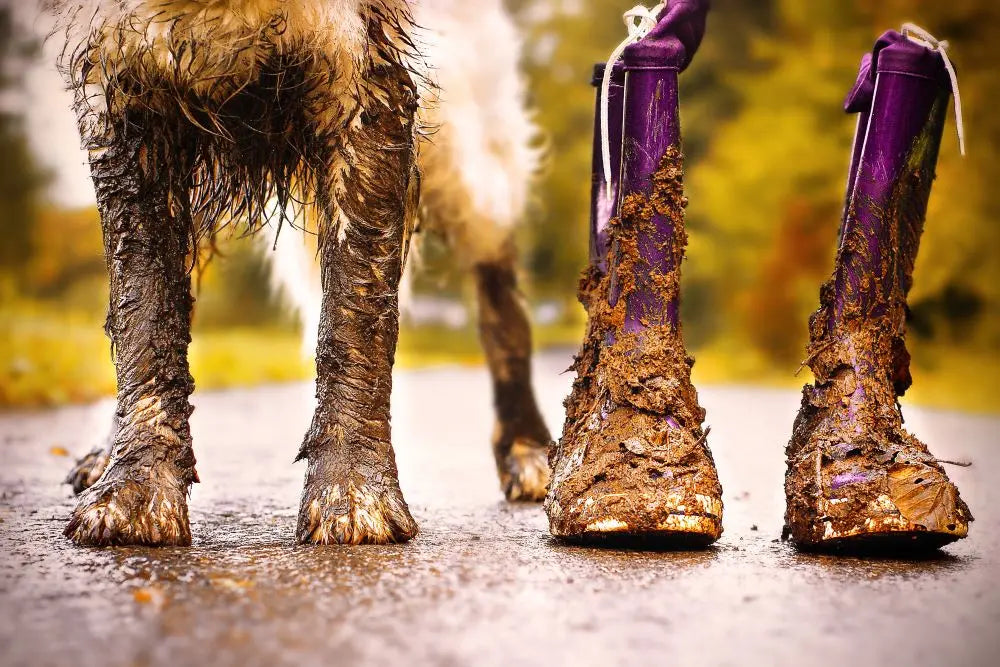From £6.99

Tips and Tricks for Cleaning Your Dog after a Day Out in the Mud
Tips for Mud-Covered Dog Care
Muddy paws and dirty fur can be a common occurrence after a fun day outdoors with your furry friend. Taking care of your dog's cleanliness and grooming is essential not only for their appearance but also for their overall health and well-being. To help you keep your dog clean and groomed after a muddy adventure, here are some top tips:
- Be prepared: Keep a towel and some wet wipes handy in your car or near your front door to quickly wipe down your dog's paws and fur before they track mud into your home.
- Use a paw protectant: Applying a paw protectant or wax to your dog's paws before heading out can help prevent mud and dirt from sticking to their pads and make it easier to clean later.
- Regular brushing: Regular brushing is essential to remove any loose dirt or debris from your dog's fur. It not only keeps their coat clean but also helps distribute natural oils and prevents matting.
- Dry shampoo: If your dog is covered in mud but doesn't necessarily need a full bath, a dry shampoo specifically designed for dogs can be a quick and convenient solution. It helps absorb excess oil and dirt, leaving your dog smelling fresh and clean.
- Consider a dog wash station: Investing in a dog wash station can make the post-muddy walk clean-up much easier. These stations typically have features like a raised platform, a hose attachment, and non-slip mats to make bathing your dog a breeze.
By following these tips, you can ensure that your dog stays clean and groomed even after the muddiest adventures. Remember, a little extra care and preparation go a long way in keeping your furry friend looking their best.
Paw Protection and Fur Brushing Tips
Paw protection and fur brushing are essential aspects of keeping your dog clean and groomed after a muddy adventure. Here are some top tips to help you with these important tasks.
First, let's talk about paw protection. Applying a paw protectant or wax to your dog's paws before heading out for a walk can make a big difference. These products create a barrier between your dog's paw pads and the muddy ground, making it easier to clean later. Look for a high-quality paw protectant that is safe for your dog's skin and non-toxic if they happen to lick their paws.
Next, let's discuss fur brushing. Regular brushing is not only beneficial for removing loose dirt and debris from your dog's coat, but it also helps to distribute natural oils and prevent matting. Invest in a good-quality brush that is suitable for your dog's fur type. If your dog has long or thick fur, you may need a brush with longer bristles or a deshedding tool to effectively remove any tangled or matted fur.
Remember to be gentle while brushing, especially if your dog's fur is tangled or muddy. Start from the ends of the fur and work your way up to avoid causing discomfort to your furry friend. Be patient and take breaks if needed, ensuring that the brushing experience remains a positive one for your dog.
By following these paw protection and fur brushing tips, you can make the cleaning process much easier and ensure that your dog looks and feels their best after a muddy adventure.
Prep before washing
Before you dive into the dog-washing process, it's important to do a little prep work to ensure a smooth and stress-free experience for both you and your furry friend. Here are some tips to get you started:
- Choose the right location: Find a spot in your home or yard that is suitable for bathing your dog. It should be an area where water won't cause damage, like a bathtub or a designated outdoor dog-washing area. Make sure the space is clean and free from any potential hazards.
- Gather your supplies: Before you begin, gather all the necessary supplies. This includes dog shampoo, a towel, a brush or comb, a non-slip mat or towel for your dog to stand on, and treats to reward good behavior during the process. Having everything within arm's reach will make the whole process more efficient.
- Secure your dog: Ensure your dog feels secure during the washing process. If your dog tends to be anxious or fidgety, consider using a non-slip mat or towel in the tub or shower to help them feel more stable. It's also a good idea to have a second person available to help hold your dog if needed.
- Wet your dog thoroughly: Before applying any shampoo, wet your dog's coat thoroughly with warm water. Use a handheld sprayer or a bucket to ensure every part of your dog's body gets wet. Avoid getting water in your dog's eyes and ears, and be gentle when wetting their face and head.
By taking the time to prep before washing, you can set the stage for a successful dog-washing experience. With everything in place and your dog feeling secure, you'll be ready to move on to the next step in the process - gentle but thorough shampooing.
Gentle but Thorough Shampooing Tips
Now that you've prepped your dog for their bath, it's time to move on to the shampooing process. It's important to be gentle yet thorough when washing your dog to ensure their coat gets clean without causing any discomfort. Here are some tips for a successful and enjoyable shampooing experience:
- Dilute the shampoo: Most dog shampoos need to be diluted before use. Follow the instructions on the bottle to create the right mixture. Diluting the shampoo not only helps distribute it more evenly but also makes it easier to rinse out.
- Start at the neck: Begin by wetting your dog's neck and applying a small amount of shampoo. Gently massage the shampoo into their fur, working your way down their body. Be sure to get every nook and cranny, including their belly, armpits, and tail.
- Use a gentle touch: While massaging the shampoo, be mindful of your dog's sensitive areas, such as their face and ears. Use a soft, circular motion and be extra gentle around these areas to avoid any discomfort.
- Rinse, rinse, rinse: Once you've thoroughly shampooed your dog, it's time to rinse off all the suds. Use lukewarm water and ensure that you rinse every part of their body, especially their underbelly and paws. Leftover shampoo can cause skin irritation if not rinsed properly.
- Towel dry: After rinsing, use a clean towel to gently dry your dog's coat. Pat them dry rather than rubbing to prevent any tangling or matting of their fur. If your dog has longer hair, you may need to use a hairdryer on a low, cool setting to ensure they're completely dry.
By following these gentle but thorough shampooing tips, you'll give your pup a clean and refreshing bath without any stress or discomfort. Remember, the key is to be gentle and take your time to ensure a positive bathing experience for both you and your furry friend.
Essential Drying Techniques
After giving your dog a refreshing bath, it's essential to properly dry them to ensure they don't get chilled and to avoid any lingering moisture that can lead to skin irritation. Here are some essential drying techniques to follow after your dog's bath:
- Start with a towel: Gently wrap your dog in a clean, absorbent towel. Press the towel against their body, patting and rubbing to soak up as much moisture as possible. Be sure to dry all the nooks and crannies, including their belly, armpits, and paws.
- Use a hairdryer: If your dog is comfortable with it, you can use a hairdryer on a low, cool setting to further dry their coat. Keep the dryer a safe distance from their fur and move it around to prevent any hot spots. Pay attention to sensitive areas, such as their face and ears, and be extra gentle in these areas.
- Brush while drying: As you dry your dog, use a brush or comb to gently brush their fur. This helps remove any remaining tangles or mats and also helps distribute natural oils for a healthy and shiny coat.
- Take breaks: If your dog gets restless or uncomfortable during the drying process, take breaks and give them some time to relax. This will help ensure a positive and stress-free experience for both of you.
By following these essential drying techniques, you'll ensure that your dog's coat is dry, clean, and healthy after their bath. Your pup will be feeling fresh and ready for their next adventure in no time!
